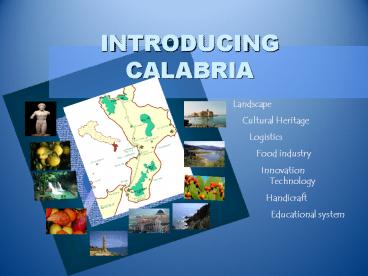INTRODUCING CALABRIA PowerPoint PPT Presentation
1 / 11
Title: INTRODUCING CALABRIA
1
INTRODUCING CALABRIA
Landscape Cultural Heritage Logistics
Food industry Innovation
Technology Handicraft
Educational system
Logo della società
2
Geography and Setting
- In Europe
- but at the heart of the Mediterranean
- A key geo-strategic position
- central to Mediterranean traffic routes
- important standpoint along euro-asian merchandise
routes (through the Suez Canal)
3
Geography and Setting
- 15.080 km2 surface
- 2.072.739 inhabitants
- 5 Provinces (administrative sub-divisions)
Catanzaro, Cosenza, Crotone, Reggio Calabria e
Vibo Valentia. - Calabria is located at the edge of the Italian
peninsula and is divided from Sicily by the
Strait of Messina.
4
Infrastructure and Logistics
- A good infrastructure system which includes
- 3 Airports
- The international Airport of Lamezia Terme,
centrally located just at the heart of Calabria
www.sacal.it - The S. Anna Airport of Crotone (east)
- www.aeroporto.kr.it
- The Airport of Reggio Calabria (south)
- www.sogas.it
- 6 Sea ports
- The hub port of Gioia Tauro (among the 30
leading World container port) - The port of Reggio Calabria (south)
- The port of Corigliano (east)
- The port of Vibo Valentia (west)
- The port of Crotone (east)
- The port of Villa S. Giovanni (south).
5
TERRITORY NATURAL, CULTURAL AND HUMAN RESOURCES
- A high literacy rate, which is around 78.3
- A high standard availability of skills which is
ensured due to the presence of 3 university
Centres in the region (Cosenza, Reggio Calabria
and Catanzaro). - 16 specialised scientific research centres
(chemistry, medical and biological centres,
agriculture, etc.)
- Calabria is endowed with 8 Parks and 780 Km of
coastline. Forests represent around 38 of the
regional land and around 7 of the whole Italian
forest land. - 45 regional Museums.
- Several archaeological sites.
- 131 coastal fortresses and castles
6
THE CALABRIAN ECONOMY
- The most recent data on Calabria shows that in
the last twenty years a primary sector economy
has given way to an advanced economy in which the
greater part of the regions wealth derives from
the tertiary sector from 58 to 68,4.
Agriculture currently records 3,3 against 5,8
in 1981 (table 1.1).
Table 1.1. The weight of agriculture on regional
added value.
Source Istituto Tagliacarne
Calabria has never had a real industrial
predisposition. In Calabria industry amounts for
15,5 compared to a national percentage of 28,2
7
THE CALABRIAN ECONOMY
Table 1.2. The weight of industry on regional
added value.
Source Istituto Tagliacarne
In the services sector, the greatest increase has
been in sales, commerce, hotels, transports,
credit, communications and insurance, even if in
smaller measure compared to the national data.
Such services generate approximately 53 of the
regional added value.
Table 1.3. The weight of the services preview for
the sale on the regional added value.
Source Istituto Tagliacarne
8
Territory and Economy
Public Administration and social Institutions
affect the regional added value. Pubic
Administration has an enormous weight on regional
occupation (table 1.4).
Table 1.4. The weight of the services on
regional added value.
Source Istituto Tagliacarne
The analysis of the regional entrepreneurship
(table 1.5) is characterized by the presence of
184.136 active enterprises, distributed mostly in
commerce (59,766) and the agro-alimentary sector
(32,768).
Calabria is characterized by small manufacturing
and services enterprises of which about 90 has
less than ten employees. Such predominance of
micro-enterprises is present in the industrial
field as well as in the agricultural, tourist and
commercial ones.
9
Territory and Economy
Table 1.5. Economic regional context.
Table 1.5. Economic regional context.
Source Istituto Tagliacarne
Source Unioncamere, 2006
10
ITALY, OCTOBER 27-DECEMBER 17 2007
11
- Useful websites
- www.itcdefazio.it
- www.istruzione.it
- www.unioncamere-calabria.it
- www.regione.calabria.it
- www.calabriascuola.it

